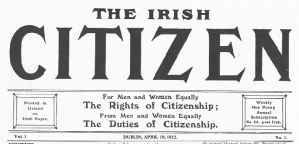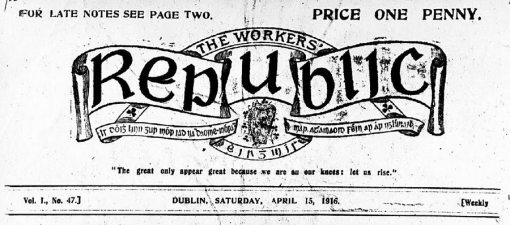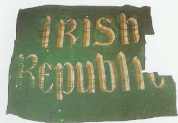Today, August 1st 2015, is the centenary of the interment of the body of Fenian leader Jeremiah O’Donovan Rossa in Glasnevin Cemetery, an event which was designed to act as the inciting incident that fueled the Irish revolution and the Proclamation of the Irish Republic less than a year later. Patrick Pearse’s graveside oration simultaneously invoked the memory of the dead and issued a call to arms in the fight for Irish freedom.
This was not a one-off, but simply the continuation of the use of funerals, memorials and commemorations to raise awareness of previous patriotic endeavour in order to fuel the drive to break the link with the coloniser and to establish an independent Irish state along republican lines.
The two extracts I use are from a thesis I wrote in 1996:
*****
(Extract 1)
‘The funeral of Terence Bellew McManus was one of the more momentous occasions in 19th-century Irish nationalist affairs. Patriotic memorialists have deemed it the effective starting point for the organization of the politics of separatism: the catalyst in the formation and expansion of Fenianism in Ireland and America’ (Bisceglia 1979: 45)
McManus had been exiled to Tasmania in 1849 for his part in the Rising, from where he escaped and made his way to San Francisco in 1851. Given a grand welcome by the local Irish community, McManus seems to have settled into a relatively quiet life until his death ten years later. He had refused, during the mid-to-late 1850s, to allow a petition for his inclusion in a general amnesty, stating –
“If the land that gave me birth – if the land sanctified to me by the graves of my forefathers – if the land of my love and affection, and for whose liberty I would cheerfully shed the last drop of my heart’s blood, cannot welcome me back without the consent of a foreign ruler, then my foot shall never press her soil”
On his death in January 1861, McManus was immediately buried in San Francisco. Within the year his remains had been disinterred by the local branch of the Fenians and placed in an ornate casket, and was the centrepiece of three major funeral processions, in San Francisco, New York, and Dublin. The final one, in Dublin, took an entire Sunday to wend its way through the streets to Glasnevin cemetery, making stops at points of nationalist interest, and accompanied or watched by many thousands of people. It was the largest event of its type since O’Connell’s funeral, and its like would not be seen again for thirty years, and Parnell’s funeral. In San Francisco and New York McManus’s body had been received into the respective cathedrals for full religious rites, but in Dublin –
‘Dr. Paul Cullen, the archbishop of Dublin, refused to bestow the clergy’s blessings upon the proceedings and closed the churches to the McManus funeral. The archbishop had been in Rome when the “Carbonari” under Mazzini had stormed the Vatican and ousted Pius IX during the revolution of 1848-9. He had spent much of his time since then in Ireland trying to swing the populace behind peaceful constitutional reform.’ (Bisceglia 1979: 59)
The McManus funeral demonstrated a number of things: the importance to nationalism of the memory of the dead; the popular support that the Fenians had both in Ireland and America; their organisational and fund-raising ability; and crucially, the degree of implacable opposition there was to physical force republicanism from the institutional Catholic Church.
‘Obviously there were at least two constituencies in Ireland: one embodied in the constitutional attachments to the crown and given expression by Archbishop Cullen; the other dedicated to a violent solution and given encouragement by the McManus funeral. It was to this latter group, this bedrock of anti-British feeling, to which the Fenians happened to appeal…Thus, with an eye on the future, they made a claim on the past.’ (Bisceglia 1979: 63)
*****
Thirty-seven years later on the occasion of the centenary of the 1798 Rising – the first manifestation of armed Irish republican resistance to British rule in Ireland – the use of memorials and commemorations were centre-stage. Worth noting was the presence among the organising centennial committee of socialist republican James Connolly whose uncles were Fenians and who would himself jointly-sign the Proclamation of the Irish Republic 18 years later and command the Dublin forces in the revolution, and pay for that with his life.
*****
(Extract 2)
The great mass of ordinary people played their part in the commemorations, with bonfires lit on important anniversaries, performances of centennial dramas in villages and towns, pageants, collections for the erection of permanent memorials, and so on. ‘A healthy rivalry developed between communities, each trying to outdo its neighbours in patriotic display.’ (O’Keefe 1992: 69) It was, however, their participation in the dedication ceremonies of memorials that was particularly impressive.
‘Only the monster meetings of Daniel O’Connell’s repeal campaign and the public gatherings connected with the Land League had brought so many people together for a single purpose over such a long period.’
(Owens 1994: 106)
As I have already pointed out, the raising of monuments in 1898 was both an act of defiance for the present and a symbolic connection between the past and the future. Coming just a year after large demonstrations held to celebrate Queen Victoria’s Jubilee year, the `98 commemorations were important reminders that, as Owens says, ‘the heart of the country remained nationalist.’ (O’Keefe: 107) There was also an educative function attached to the monuments, and the process surrounding them.
‘Nationalists also believed that memorials to dead heroes could teach the country’s youth priceless lessons in history. As one monument promoter contended: “in [the] absence of the systematic teaching of our country’s history in the schools, these monuments will be to the child the illustrations of a portion of our national story”.’ (O’Keefe: 108)
This emphasis on the need to teach the coming generation the story of the nation is echoed by Brown some seventeen years later, just before the Rising in 1916.
‘…why not see to it that among the works of fiction put into the hands of Irish boys and girls there shall be found some that will imprint in their imaginations what of Irish history is best worth remembering, and that will help to fix their affections upon the country whose children they are.’ (Brown 1916: 95)
As Owens says, it is impossible to know what the young people themselves thought of the monuments, or if they took from them what the adults hoped they would. But in the main it would be the children of 1898 who would, eighteen years later, be members of the generation who were ‘out’ in 1916 and thereafter.
The sites where these monuments would be had relevance too. They needed to be highly visible, so were placed in a busy area. They might be positioned at one of the ‘stations’ on the ‘via Dolorosa’ I mentioned earlier, or even create a new one. They would also serve as a rallying point for meetings and demonstrations. The choice of site could also be used provocatively, as in the siting of the foundation stone for the Wolfe Tone statue right in the heart of unionist Dublin at the top of Grafton Street.
Where it was not possible to site the monument on what Owens describes as the ‘sacred spot’, then a piece of the spot might be brought to the monument site, for instance the use of stone from a battlefield to make the monument or foundation. (Owens 1994: 110) This emphasis on relics is tied into the way in which monuments were treated almost as sacred objects, and in the use of religious discourse about the monument in terms such as ‘shrine’, martyr’, etc. (Ibid: 111)
The Wolfe Tone monument provides a good example of these points. The foundation stone was quarried from Cave Hill near Belfast, where Tone and the Belfast United Irishmen had sworn to their course of action. Its choice of source also allowed the Belfast republicans to have an input into the commemoration. It would not have been possible for them to have their own commemoration in the sectarian Belfast of the late nineteenth century.
When the stone arrived in Dublin by train it was treated much as the body of a hero might have been, with a lying-in-state for two days on the site of the old Newgate prison, prior to its carriage through the ‘via Dolorosa’ – the route which took it past the places associated with Tone, Emmet and so on. The city had shut down for the day, and the huge procession took three hours to cover the three mile route. It was the largest public gathering since the unveiling of the O’Connell monument, with the crowd estimated to number one hundred thousand. (Owens: 111-3)
When the veteran Fenian John O’Leary had finished the ceremonial laying of the stone, he tapped the trowel, which had been donated for the occasion by one of Tone’s grand-daughters, six times on the stone, one for each of the four provinces, and once each for the United States and France.
‘Then, at a signal from the platform, a band struck up the theme song of the centenary, ‘The Memory of the Dead’. As they began to play, members of the crowd removed their hats and stood silently or sang the well-known lyrics that began, ‘Who fears to speak of `98?’ (Owens: 114)
This then was the centrepiece of the `98 commemorations. When a monument to Tone was finally unveiled, the independent state would have already celebrated the fiftieth anniversary of the Rising of 1916.
*****
The ‘independent state’? The Irish state doesn’t qualify as such since independence has been surrendered to the European Union and to the Eurozone. The nominal independence we ‘enjoyed’ prior to that was used for the benefit of an ‘elite’ class – the wealthy, professionals, the Catholic Church, and their political fixers and assorted useful facilitators including media owners.
The current Fine Gael-Labour government, driven by a hatred and fear of 1916 which challenges the corporatist nature of this state with an alternative set of higher ideals and promises, struggled to overwhelm the upcoming centenary of the 1916 revolution with a spate of other centennials until forced to change course through the weight of public opinion.
Today’s state commemoration of the O’Donovan Rossa centenary is a deeply cynical enterprise. The political class has been forced to swallow hard, to grin and bear it, conscious of the threat to its existence should the despised ‘non-elite’ mass element of citizens engage in a re-examination of the promise of the Proclamation and of the Republic so deliberately extinguished by the first Free State government and all subsequent governments
If the O’Donovan Rossa funeral was the inciting incident for the 1916 revolution, could it be that the centenary of that funeral, the first in a series of commemorations which will culminate in the Republic Day 1916 commemorations on April 24th 2016, will be an inciting incident leading to the preparation for a democratic revolution by the Demos?
If so, we might imagine a ghostly smile from Wolfe Tone, Terence Bellew McManus, Jermiah O’Donovan Rossa and James Connolly.
And their nods of approval.
 There was also in Ireland a strong women’s franchise movement, with the Irish Women’s Franchise League (IWFL) the most militant of a large number of groups throughout the country. It was founded by Hanna Sheehy-Skeffington and Margaret Cousins in 1908 and was pledged to: non-party independent action; vigorous agitation; organisation of women; education of public opinion. Although most of the members were nationalists, women of all political persuasions were welcomed. Within a short time 800 members were on the register. The League organised militant action on a regular basis, both in Ireland and in England, and members of the League were regularly imprisoned. They adopted the tactic of the hunger strike, which the authorities countered first through forcible feeding, and also through early release and re-arrest, or the ‘cat and mouse’ tactic.
There was also in Ireland a strong women’s franchise movement, with the Irish Women’s Franchise League (IWFL) the most militant of a large number of groups throughout the country. It was founded by Hanna Sheehy-Skeffington and Margaret Cousins in 1908 and was pledged to: non-party independent action; vigorous agitation; organisation of women; education of public opinion. Although most of the members were nationalists, women of all political persuasions were welcomed. Within a short time 800 members were on the register. The League organised militant action on a regular basis, both in Ireland and in England, and members of the League were regularly imprisoned. They adopted the tactic of the hunger strike, which the authorities countered first through forcible feeding, and also through early release and re-arrest, or the ‘cat and mouse’ tactic. The Shan Van Vocht
The Shan Van Vocht
 The Irish Citizen
The Irish Citizen

